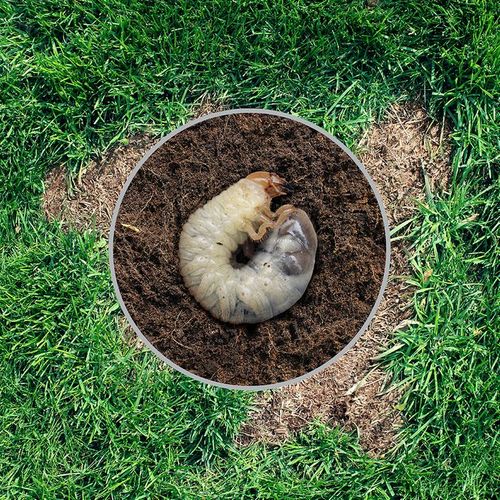Have you ever looked out the window at your otherwise perfect lawn, and saw skunks or crows digging away as if they are searching for buried treasure? They are most likely looking for white grubs that are inhabiting your lawn.
So, what are white grubs? They are the larval life stage of several different types of scarab beetles, mostly Japanese beetle or European chafer in our area. The beetles themselves are major pests of trees, shrubs, and gardens. However, they lay their eggs in your lawn, which gives rise to white, C-shaped worm-like creatures that exist in the root zone of your lawn and, naturally, feed on its roots.
LIFE CYCLE OF WHITE GRUBS
The new grubs hatch in the summer (mid/late August) and immediately begin feeding on the roots of the turf as small, first-instars. By late September to early October, they have molted into slightly larger second instars and continue to feed voraciously. Finally, by late October they molt again into large third-instar grubs, feed for a short time and then begin to move down below the frost line to overwinter. When soil temperatures warm in early spring, the large grubs move back into the turf root zone and feed again, before pupating into adult beetles and starting the entire process over again. A graphic of the generic white grub life cycle is shown below. I say generic because with different species comes variations of this. In any case, white grubs are by far the most destructive insect pests that we deal with in lawn care.

HOW TO FIX DAMAGE FROM WHITE GRUBS
While it is important to know the details of the pest you may be dealing with, most folks simply want to know how to fix the problem. The answer, however, isn’t always cut and dry. The approach that should be taken to control them depends on a few factors; the most important of which is when you actually discover that you have a grub problem.
Let’s say that you discover grubs in your lawn now. Those grubs have been there since late last summer, and are the largest they will be in their life cycle. The best thing to do is apply a preventative application, which will remain in the soil through the time when the new generation of beetles are laying their eggs. Once the tiny new grubs begin to feed on the roots, they absorb the product and are prevented from developing further.
Many people may ask “What about the grubs that are feeding on my lawn now, shouldn’t those be controlled?” The answer to that is: they can be controlled now, but the overall percentage controlled will be low. Beyond that, it’s essentially a lost cause at this stage. Because the grubs have been around and feeding since the previous summer they are large, thus harder to control with the limited curative products that are available. So, unless it is an extremely high-value turf area, curative applications in the spring are not usually recommended as the majority of the damage has already been done.
STEP-BY-STEP
Before any chemical applications are made, it is important to remember that in most cases the damage must be repaired first. While some patchy areas may be salvageable via fertilizer and weed control applications, in many cases replanting of the lawn areas is necessary.
There are many different approaches to getting new grass established, but at minimum, the dead chunks of grass and associated soil should be cleaned up, and the area smoothed out. Good seed-to-soil contact is key, but unless the existing soil is poor or the grade of the area needs repair adding new/more soil is not necessary.
Any preventative grub control applications should be made as the last step in this process, as once they are applied there should be no further movement or disturbance of the soil as this would break the preventative barrier being applied.

PREVENTATIVE GRUB APPLICATIONS
White grubs are a major turf pest and can wreak havoc on an otherwise healthy lawn. Yearly preventative applications are the best defense against grub infestations. While some people may not see the value in an application for something that can only happen in the future, my words of advice are that the cost of a preventative application is much cheaper than what it would take to fix areas damaged by grubs, not to mention much less aggravation!
Call us today at (207) 544-9420 to add a preventative grub application to your lawn!

